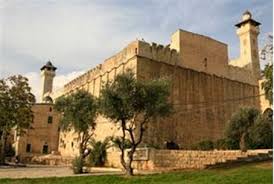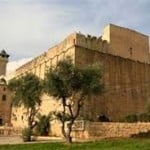In the Torah portion of Chayei Sarah we read of the lengthy deliberations regarding the purchase of a burial plot for Sarah. Sixteen verses describe the search, the request and finally the purchase of the cave of the Machpelah .
In fact there are in fact three such discussions regarding land purchases in the Tanach. In Midrash (Breishit Rabba 79,7), the sages wonder why in those three Biblical passages we are told all the details of the financial negotiations.
They explain that these three places in the land of Israel, were to be metaphors for a land that would belong to the people of Israel eternally– even by the right of purchase and yet would be disputed by all the nations.
Those three locations mentioned in the Biblical text are the tomb of the patriarchs and matriarchs in the Cave of Machpelah in Hebron(Genesis 23:16) , the Tomb of Joseph in Shechem- Nablus (Genesis 33:19), and the site of the Temple in Jerusalem. (I Chronicles 21:24-25)
So it is not surprising, that thousands of years later, it is these three locations that consistently flare up as the hot spots in the Arab -Israeli conflict. In this part of the world metaphors and symbols develop into real and dangerous life and death situations. Signposts and narratives become the arbiters of reality. It is around these three locations that much passion has been stirred and much theology has been reconstructed.
Regrettably much blood has been spilled as well. The locations that have been purchased by Biblical deed become the locations that need to be uprooted by our enemies before all else. The forces who would consciously or unconsciously wish to deflect the direction of Biblical destiny would need to begin by uprooting these signposts.
Yet the Malbim offers another fascinating insight into the purchase. Abraham’s purchase of an eternal resting place for Sarah was to be an eternal lesson in theology. The Malbim proposes that until the burial of Sarah, bodies would be buried in order to put away decaying flesh. Once time has passed that same burial plot would be used for someone else.
That is why the sons of Chet urge Abraham to feel free to use of their graves for Sarah “Listen to us, my lord; you are a prince of G-d in our midst; in the choicest of our graves bury your dead. None of us will withhold his grave from you to bury your dead.” (Genesis 23 6)
Abraham’s responds by asking them to entreat Ephron on his behalf “That he may give me the Machpelah Cave, which belongs to him, which is at the end of his field; for a full price let him give it to me in your midst for burial property.”( ibid:9)
That purchase established a new reality. An eternal resting place for a mortal being that had been once the vessel for an eternal soul.
“And the field and the cave within it were established to Abraham as burial property, [purchased] from the sons of Heth.” ( ibid 23:20)
We read further with Jacob that he too was adamant in his instructions to his children regarding his burial place
“I am to be gathered to my people; bury me with my fathers in the cave that is in the field of Ephron the Hittite, in the cave that is in the field at Machpelah, to the east of Mamre, in the land of Canaan, which Abraham bought with the field from Ephron the Hittite to possess as a burying place..” ( Genesis 49:29-30)We see a similar concert expressed by Joseph to his brothers regarding the location of his ultimate burial place (Genesis 50:25).
The deep lesson gleaned from all this according to the Malbim is a confirmation of the belief that man is not destined to be discarded after death. Rather the individual physical body is laid to rest as its soul returns to the heavens. The soul continues to exist.
Furthermore as we read in the book of Daniel “Many of those who lie dead in the ground will rise from death.”( Daniel 12:2). There will be the time wherein our physical existence will be renewed with spiritual fullness. The purchase and edification of an eternal resting place is statement of the eternity of the soul and the belief in G-d’ promise of a new revived spiritual reality.
In days when we are burying our young people ,First Sergeant Almog Shiloni and Dalia Lemkos hy”d, butchered by Palestinian terrorists those thoughts offer some comfort.
The purchase in Hebron taught two lessons. The first is that the people of Israel are here by deed and inheritance. So all those engaged in terror and threats will be frustrated in their plans.
Secondly that in the midst of the pain and loss it is important to remember the immortality of the soul and the promise of the final redemption.
May Hashem comfort the families of the murdered young people and heal the wounded. May Hashem avenge the blood that was shed and may their precious souls rest comfortably under the wings of the Divine presence
LeRefuat Yehudit bat Golda Yocheved

